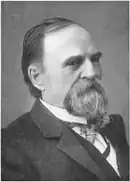 | |
| Type | Corporation |
|---|---|
| Industry | Glass manufacturing |
| Predecessor | Buttler Art Glass Co. |
| Founded | 1890 |
| Defunct | 1893 |
| Fate | Dissolved |
| Successor | Factory T of United States Glass Company |
| Headquarters | |
Key people | Rawson Crocker, Henry Crimmel |
| Products | stemware, bar goods, novelties |
Number of employees | 100 (Factory T 1892) |
Novelty Glass Company of Fostoria was one of over 70 glass manufacturing companies that operated in northwest Ohio during the region's brief Gas Boom in the late 19th century. The company made bar goods, stemware, and novelties. Organization of the firm began late in 1890, with banker Rawson Crocker as president and veteran glass man Henry Crimmel as plant manager. Production started in February 1891. The plant was built on the site of the former Buttler Art Glass Company (spelled with two "t"s), which had been destroyed by fire in 1889.
During the early 1890s, many manufacturers were producing novelties that honored the 400th anniversary of the voyages of Christopher Columbus. Novelty Glass Company's contribution included commemorative punch bowl sets and salt shakers. Some of this glassware displayed Columbus with a beard—which was rarely done. This commemorative work has subsequently become valuable to collectors.
Like many companies during northwest Ohio’s brief Gas Boom, the Novelty Glass Company was short-lived. The plant was shut down in January 1892, with a restart planned for April. The April restart did not happen, and plant manager Henry Crimmel left the firm for the Sneath Glass Company in Tiffin, Ohio. In October of the same year, the Novelty plant was leased to the United States Glass Company, who also purchased the plant's inventory of molds and related equipment. Production began again, and the Novelty works became known as Factory T in the United States Glass Company conglomerate. Approximately 100 people were employed making drinking glasses and stemware. The restart did not last long, however. The plant was destroyed by fire in April 1893.
History
Northwest Ohio gas boom
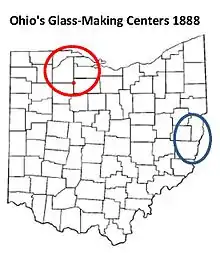
In early 1886, a major discovery of natural gas occurred in northwest Ohio near the small village of Findlay.[1] Although small natural gas wells had been drilled in the area earlier, the well drilled on property owned by Louis Karg was much more productive than those drilled before. Soon, many more wells were drilled, and the area experienced an economic boom as gas workers, businesses, and factories were drawn to the area.[2] In 1888, Findlay community leaders, assuming the supply of natural gas was unlimited, started a campaign to lure more manufacturing plants to the area. Incentives to relocate to Findlay included free natural gas, free land, and cash.[3] These incentives were especially attractive to glass manufacturers, since the glass manufacturing process is energy-intensive.[4] Although coal was the most common fuel used for glass making at the time, natural gas is a superior fuel because it reduces the time it takes to melt the raw materials and enables better quality glass.[5]
Ohio already had a glass industry located principally in the eastern portion of the state, especially in Belmont County. The Belmont County community of Bellaire, located on the Ohio side of the Ohio River across from Wheeling, West Virginia, was known as "Glass City" from 1870 to 1885.[6] The gas boom in northwestern Ohio enabled the state to improve its national ranking as a manufacturer of glass (based on value of product) from 4th in 1880 to 2nd in 1890.[7] Over 70 glass companies operated in northwest Ohio between 1880 and the early 20th century.[8] However, northwest Ohio’s gas boom lasted only five years. By 1890, the region was experiencing difficulty with its gas supply, and many manufacturers were already shutting down, using alternative fuels, or considering relocating.[8]
Fostoria
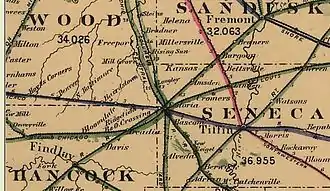
Fostoria, Ohio, is located 12 miles (19 km) east of Findlay, and straddles three Ohio counties: Hancock, Seneca, and Wood.[9] The high-output gas well that changed the area’s economy, the Karg well drilled in January 1886, was located in the Hancock County village named Findlay.[10] After the Karg discovery, geologists determined that natural gas would not be found in the immediate area around Fostoria.[11] However, Fostoria government leaders constructed a pipeline from a nearby well in Wood County, and this enabled Fostoria to participate in the rush to lure manufacturers to the area.[12] Fostoria had a transportation advantage: numerous railroad lines ran through the city.[13][Note 1]
The first glass factory established in Fostoria were the Mambourg Glass Company, which first produced window glass cylinders on October 26, 1887.[15] The next glass works was the Fostoria Glass Company, which was founded by veteran glass men from West Virginia. This company became the town's most famous glass factory.[16] The third glass factory was the Buttler Art Glass Company, which was incorporated in 1887 but did not finish construction of its glass works until February 22, 1888. Among its investors were local banker Rawson Crocker and former Ohio governor Charles Foster.[17] Eventually, Fostoria had 13 different glass companies at various times between 1887 and 1920.[18][Note 2]
Organization
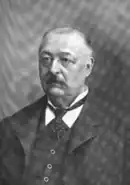
Events at two other Fostoria glass factories led to the creation of Novelty Glass Company. First, the Buttler Art Glass plant burned to the ground in November 1889. Owners of the plant decided to rebuild elsewhere, since the site had few fire hydrants and inferior water pressure.[21][Note 3] The second event involved the Fostoria Glass Company. Owners of this company became concerned about natural gas shortages in 1890, and in April 1891 decided to move to Moundsville, West Virginia.[24] Plant manager (and shareholder) Henry Crimmel was involved in a lawsuit that sought to prevent the move. Although a temporary restraining order was granted, the company moved to Moundsville during December 1891.[25]
During late 1890, planning began to organize a new glass works that would be built on the site of the former Buttler Art Glass Company. The new glass works was to be called Novelty Glass Company. The seven incorporators of the company were Rawson Crocker, Andrew Emerine, Charles Olmsted, C. German, George Flechtner, A. C. Crimmel, and Henry Crimmel. The company’s directors were Crocker, Olmsted, Emerine, Henry Crimmel, and Charles Foster.[26] The two Crimmels provided glass making expertise with their experience at the Fostoria Glass Company.[27] Henry Crimmel had also previously worked at Belmont Glass Company in Bellaire, Ohio, and at J. H. Hobbs, Brockunier and Company in Wheeling, West Virginia.[28] Crocker (Foster's cousin), Olmsted (Foster's brother-in-law), and Emerine were prominent Fostoria capitalists.[27] Crocker was an officer of a local bank, and president of the Crocker Window Glass Company.[27] Crocker was named president of the new company, and Emerine was treasurer. A. C. Crimmel was company secretary, while Henry Crimmel was plant manager.[29][Note 4]
The company was expected to employ about 150 people.[31] Plans for the new glass works included a medium-sized 11-pot furnace and three lehrs for cooling the glass.[32][Note 5] Production was expected to begin in early February 1891.[32] Advertising by the new glass works called the company "The Fostoria Novelty Glass Company", and news articles called the new company both "Fostoria Novelty Glass Company" and "Novelty Glass Company". (An unrelated company called Fostoria Glass Novelty Company started about 25 years later.)[34] The company’s products were described in advertisements as "fine lead blown tumblers, bar goods, stemware, and novelties".[35] Pressed glassware was also part of the planning. In late 1890, Henry Crimmel had made a trip to Bellaire, Ohio, where he purchased some molds from the Belmont Glass Company. The Belmont works had shut down earlier in the year, and Crimmel had been a manager at that plant before leaving for the Fostoria Glass Company.[36]
Production
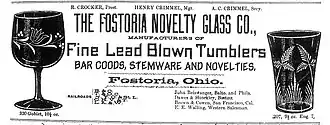
Production began on February 4, 1891 with blown glass tumblers.[31] The factory began with a "light force of people", and it was not expected to operate at full capacity until close to the end of the month.[31] Production went well, and continued until the two–month shutdown during the summer—a normal procedure for glass factories in that time period. After the end-of-summer startup, the factory restarted and produced through December.[31]
At the time the Novelty Glass Company began production, the 400th anniversary of Christopher Columbus’ discovery of America (in 1492) was only a year away. The World’s Fair, also called the Columbian Exposition, was being held in Chicago in 1893 to celebrate this occasion, and many manufacturers were producing items to commemorate both Columbus and the World’s Fair.[37] The Novelty Glass Company produced punch bowl sets and salt shakers honoring Columbus and Queen Isabella, who financed the expedition. Some of the punch bowl cups and salt shakers featured the explorer with a full beard—which was not done often at that time.[38][Note 6] The cup has been described as "embossed clear pressed glass" with a "gilt painted bust of Columbus".[40] The salt shaker was made of opalware and clear glass, and mold blown and pressed.[40] Because of the short life of the Novelty Glass Company, and the uniqueness of its Columbus glass novelties, those products are valuable to collectors.[40][Note 7] Typical of many valuable collectibles, potential buyers should be alert for forgeries. At least one bearded–Columbus salt shaker has been painted for the purpose of increasing its value.[42][Note 8]
Decline
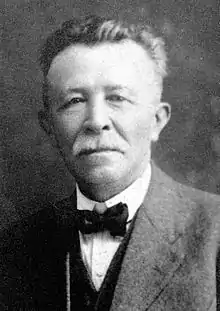
The U.S. economy suffered through multiple recessions during the 1880s and 1890s, making life difficult for manufacturing firms. The U.S. business cycle peaked during July 1890, and declined until May 1891.[44] Although Novelty Glass restarted after the summer break in 1891, it shut down again in January 1892 because of a lack of orders. The original plan was to restart in April, but the shareholders decided during April that it was not worth reopening for the short period from April to the summer break.[31] During May 1892, plant manager Henry Crimmel left town to become the manager of Sneath Glass Company in Tiffin, Ohio.[45]
After not reopening following the summer break, the shareholders sold Novelty’s equipment to the United States Glass Company in October. The conglomerate also leased Novelty’s glassmaking plant.[31] The plant began operating as Factory T of the United States Glass Company, and had 100 employees. On April 1, 1893, like the Buttler Art Glass plant a few years earlier, the glass works was destroyed by fire.[46] Management at the U.S. Glass Company decided not to continue operations at the Factory T location. Shareholders of the Novelty Glass Company still owned the land and the ruins of the plant, and voted to liquidate the property in January 1896.[47]
Notes
Footnotes
- ↑ The Fostoria Novelty Glass Co., in an 1891 advertisement, listed five railroads serving the town: the Baltimore and Ohio Railroad; the Toledo and Ohio Central Railway; New York, Chicago and St. Louis Railroad (a.k.a. the Nickel Plate Railroad); the Columbus, Hocking Valley and Toledo Railway; and the Lake Erie and Western Railroad.[14]
- ↑ The count of Fostoria glass companies varies depending on how restarts and reorganizations are counted. The Fostoria Ohio Glass Association lists 13 companies for 1887-1920.[19] Jack K. Paquette discusses 15 companies plus four post-boom companies in Chapter V of his Blowpipes book.[20]
- ↑ Murray cites the November 28, 1889, edition of Crockery & Glass Journal for information on the fire at the Buttler Art Glass works.[22] He cites the February 13, 1890, edition of Crockery & Glass Journal for information concerning the decision to not rebuild the factory.[23]
- ↑ At that time, Alva Clyde Crimmel was sometimes identified by the press as Henry Crimmel’s brother.[29] However, he was identified as Henry Crimmel’s son in the elder Crimmel’s 1917 obituaries.[30]
- ↑ Because most glass plants melted their ingredients in a pot, the plant's number of pots was often used to describe a plant's capacity. The ceramic pots were located inside the furnace. The pot contained molten glass created by melting a batch of ingredients that typically included sand, soda, lime, and other ingredients.[33]
- ↑ Compare the bearded Christopher Columbus with the United States commemorative coin featuring Columbus on the Columbian half dollar.[39]
- ↑ A 1998 book valued the Columbus and Isabella salt shakers as rare, $850 to $900 (equivalent to $1,571 in 2022) per pair.[41]
- ↑ The Lechners devote a section of their book to “Reproductions, Look Alikes, Reissues, and Fakes” on pages 269-296.[43]
Citations
- ↑ Paquette 2002, pp. 24–25; Skrabec 2007, p. 7
- ↑ Paquette 2002, pp. 24–25
- ↑ Paquette 2002, p. 26
- ↑ "Glass manufacturing is an energy-intensive industry mainly fueled by natural gas". U.S. Energy Information Administration. Archived from the original on March 27, 2023. Retrieved March 27, 2023.
- ↑ Weeks & United States Census Office 1884, p. 36
- ↑ McKelvey 1903, p. 170
- ↑ United States Census Office 1895, p. 315
- 1 2 Paquette 2002, p. 28
- ↑ Murray 1992, p. 12; H. Sabine (1882). New Rail Road Map of Ohio prepared by H. Sabine, Commissioner of Rail Roads & Telegraphs (Map). Wapakoneta, Ohio: R. Sutton (from Geography and Map Division, Lib. of Congress). Archived from the original on March 27, 2023. Retrieved September 20, 2020.
- ↑ Skrabec 2007, p. 25; Murray 1992, p. 11; Paquette 2002, p. 24
- ↑ Murray 1992, p. 12; Paquette 2002, p. 172
- ↑ Murray 1992, p. 13; Geological Survey of Ohio 1890, p. 190
- ↑ H. Sabine (1882). New Rail Road Map of Ohio prepared by H. Sabine, Commissioner of Rail Roads & Telegraphs (Map). Wapakoneta, Ohio: R. Sutton (from Geography and Map Division, Lib. of Congress). Archived from the original on March 27, 2023. Retrieved September 20, 2020.
- ↑ "The Fostoria Novelty Glass Co. (advertisement on page 16)". China, Glass and Lamps. May 13, 1891.
- ↑ Paquette 2002, pp. 175–176; Murray 1992, p. 19
- ↑ Paquette 2002, p. 179
- ↑ Paquette 2002, pp. 184–185
- ↑ "Fostoria Ohio Glass Association". Fostoria Ohio Glass Association. Archived from the original on March 28, 2023. Retrieved March 27, 2023.
- ↑ "Fostoria Ohio Glass Association". Fostoria Ohio Glass Association. Archived from the original on August 10, 2022. Retrieved March 27, 2023.
- ↑ Paquette 2002, pp. 170–229
- ↑ Paquette 2002, pp. 187–188; Murray 1992, pp. 101–102
- ↑ Murray 1992, pp. 101–102
- ↑ Murray 1992, p. 102
- ↑ Paquette 2002, p. 181
- ↑ Murray 1992, pp. 57–58; Paquette 2002, pp. 82–83; "A Temporary Restriction - Trouble Experienced in the Removal of the Fostoria Glass Works". Pittsburgh Dispatch. December 8, 1891. p. 12.
A temporary restraining order has been granted....
; "About People - Daily Chronicle of the Movement of Individuals". Daily Register (Wheeling). January 12, 1892. p. 5.W.S. Brady, of the Fostoria Glass Company, of Moundsville.... We will start up next Monday.
- ↑ "Untitled (right column of page 1, 1/3 down)". Elmore Independent (Ohio). November 21, 1890. p. 1.
The Fostoria Novelty Glass Company was organized....
; Murray 1992, p. 33; Paquette 2002, p. 205 - 1 2 3 Paquette 2002, p. 205
- ↑ Venable et al. 2000, p. 174
- 1 2 Paquette 2002, pp. 205–206
- ↑ "H. Crimmel Drops Dead on Street". Hartford City News. October 10, 1917. p. 1.; "Henry Crimmel Dead". National Glass Budget. Pittsburg, Pennsylvania. 33 (23): 1. October 13, 1917. Archived from the original on August 21, 2023. Retrieved August 26, 2023.
- 1 2 3 4 5 6 Paquette 2002, p. 206
- 1 2 Murray 1992, p. 33; "Industrial Items". Pittsburg Dispatch. January 31, 1891. p. 2.
The Novelty Glass Company, of Fostoria, O., will likely be ready for operation by the middle of next week. It is an 11-pot furnace.
- ↑ Skrabec 2007a, pp. 25–26
- ↑ Reed 2005, p. 1; "The Fostoria Novelty Glass Co". China, Glass & Lamps. Pittsburgh: 16. May 13, 1891.; "Fostoria Organization Completed". National Glass Budget. Pittsburgh, Pennsylvania. 31 (17): 6. September 4, 1915. Archived from the original on August 27, 2023. Retrieved August 27, 2023.
- ↑ "The Fostoria Novelty Glass Co". China, Glass & Lamps. Pittsburgh: 16. May 13, 1891.
- ↑ Murray 1992, p. 33; "Untitled (third column from left, half down)". Daily Register (Wheeling). November 26, 1890. p. 2.
Henry Crimmel, manager of the Novelty Glass Works, at Fostoria....
; Lechner & Lechner 1998, p. 144 - ↑ Reed 2005, p. 2; "Blog - The Souvenirs and Stories of the 1893 World's Columbian Exposition". Chicago History Museum. Archived from the original on August 27, 2023. Retrieved August 27, 2023.
- ↑ Murray 1992, pp. 33–34
- ↑ "1892-1893 World's Columbian Exposition Half Dollar". American Numismatic Association. Archived from the original on August 27, 2023. Retrieved August 27, 2023.
- 1 2 3 Lechner & Lechner 1998, p. 145
- ↑ Lechner & Lechner 1998, p. 144
- ↑ Lechner & Lechner 1998, p. 281
- ↑ Lechner & Lechner 1998, pp. 269–296
- ↑ "US Business Cycle Expansions and Contractions". National Bureau of Economic Research. Archived from the original on December 1, 2019. Retrieved March 31, 2023.
- ↑ Murray 1992, p. 34; Paquette 2002, p. 439; "Untitled (2nd column from left, near bottom)". Wheeling Daily Intelligencer. October 3, 1892. p. 3.
Henry Crimmel...now managing a glass factory at Tiffin.
- ↑ Paquette 2002, p. 217; "All Over Ohio - Happenings in Buckeyedom Briefly Stated". Sandusky Daily Register. April 5, 1893. p. 4.
The United States Glass factory at Fostoria burned to the ground.
; "Glass Works Burned". Norwalk Daily Reflector. April 4, 1893. p. 1.The Novelty glass works were destroyed by fire Sunday morning.
- ↑ Paquette 2002, p. 218
References
- Geological Survey of Ohio (1890). Annual Report of the Geological Survey of Ohio. Columbus, Ohio: Westbote Co., State Printers. OCLC 13585464. Archived from the original on August 3, 2023. Retrieved August 4, 2023.
- Lechner, Mildred; Lechner, Ralph (1998). The World of Salt Shakers: Antique & Art Glass Value Guide Volume III. Paducah, Kentucky: Collector Books. ISBN 9781574320657. OCLC 39502285.
- McKelvey, Alexander T. (1903). Centennial History of Belmont county, Ohio and Representative Citizens. Chicago: Biographical Publishing Company. OCLC 318390043.
Centennial history of belmont county.
- Murray, Melvin L. (1992). Fostoria, Ohio Glass II. Fostoria, OH: M. L. Murray. OCLC 27036061.
- National Glass Budget (1917). "Henry Crimmel Dead". Nation Glass Budget Weekly Review of the American Glass Industry. Pittsburgh: National Glass Budget. 33 (23). OCLC 473116336. Archived from the original on April 7, 2022. Retrieved December 15, 2020.
- Paquette, Jack K. (2002). Blowpipes, Northwest Ohio Glassmaking in the Gas Boom of the 1880s. Xlibris Corp. ISBN 1-4010-4790-4. OCLC 50932436.
- Reed, Sarah M. (2005). "Novelty Glass Company (1890-1893) and Fostoria Glass Novelty Co. (c. 1915-1917)". Victoria Views. Fostoria, OH: The Fostoria, Ohio Glass Association. 12 (4 (December)).
- Skrabec, Quentin R. (2007). Glass in Northwest Ohio. Charleston, South Carolina: Arcadia. ISBN 978-0-73855-111-1. OCLC 124093123.
- Skrabec, Quentin R. (2007a). Michael Owens and the Glass Industry. Gretna, Louisiana: Pelican Publishing. OCLC 137341537.
- United States Census Office (1895). Report on manufacturing industries in the United States at the eleventh census: 1890. Washington: Government Printing Office. OCLC 10470409.
- Venable, Charles L.; Jenkins, Tom; Denker, Ellen P.; Grier, Katherine C. (2000). China and Glass in America, 1880-1980: from Tabletop to TV Tray. Dallas: Dallas Museum of Art. ISBN 978-0-81096-692-5. OCLC 905439701.
- Weeks, Joseph D.; United States Census Office (1884). Report on the Manufacture of Glass. Washington, District of Columbia: U.S. Government Printing Office. OCLC 2123984. Archived from the original on June 26, 2023. Retrieved June 26, 2023.
External links
- Columbus and bearded Columbus - Early American Pattern Glass Society
- Fostoria, Ohio Glass Association
